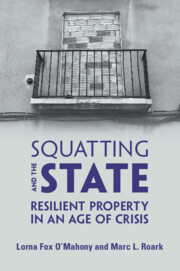Book contents
- Squatting and the State
- Squatting and the State
- Copyright page
- Dedication
- Contents
- Preface and Acknowledgments
- Introduction Squatting, Scale, and the State
- Part I Squatting and the State
- Part II Resilient Property in an Age of Crises
- Part III Resilient Property in Action
- 9 Scaling Resilience and the State
- 10 Postscript: Resilient Property and the Pandemic
- Bibliography
- Index
9 - Scaling Resilience and the State
from Part III - Resilient Property in Action
Published online by Cambridge University Press: 11 August 2022
- Squatting and the State
- Squatting and the State
- Copyright page
- Dedication
- Contents
- Preface and Acknowledgments
- Introduction Squatting, Scale, and the State
- Part I Squatting and the State
- Part II Resilient Property in an Age of Crises
- Part III Resilient Property in Action
- 9 Scaling Resilience and the State
- 10 Postscript: Resilient Property and the Pandemic
- Bibliography
- Index
Summary
States make decisions to allocate resilience to (or withhold resilience from) stakeholders across these networked interests through the lens of the state’s own vulnerability and resilience needs. We have revealed how the state’s “other-regarding” responsibility to govern in the “collective interest” – allocating resilience to shore up particular (competing) individual, aggregated and/or institutional claims – and the state’s own “self-regarding” need to shore up its resilience vis-à-vis citizens, markets, and society – interact to produce and provoke state responses to squatting. Finally, because Resilient Property analyses seek to explore as much as possible of the “problem space,” we have looked beyond the horizontal scale of national legislation or litigation to investigate how multi-scalar states craft complex solutions to complex problems. This includes tailoring responses to the specific needs and priorities, pressures and strains, commitments and constraints, that come to fore at the local, regional, national or supra-national level. Multilayered responses to squatting allow scope for normative hybridity within state responses to “wicked” property problems, in ways that can support systemic equilibrium. In the first part of this chapter, we reflect on three types of state responses to squatting: (1) property/private law responses; (2) criminal justice/law-and-order responses; and (3) responses deploying other administrative functions of the state. We consider how state responses reflect alignments between state self-interest and selected aspects of the state’s other-regarding responsibilities; and how they contribute (or not) to restoring equilibrium and shoring up the authority and legitimacy of the state in moments of crisis. These national-jurisdiction level legal responses are embedded within a polycentric, multimodal, and multi-scalar matrix. In the second part of the chapter, we examine two city-level case studies: New York City and Barcelona – to reflect on moments in which local- or city-level responses were key to restoring equilibrium, or triggering tipping-points for change.
Keywords
- Type
- Chapter
- Information
- Squatting and the StateResilient Property in an Age of Crisis, pp. 339 - 378Publisher: Cambridge University PressPrint publication year: 2022

